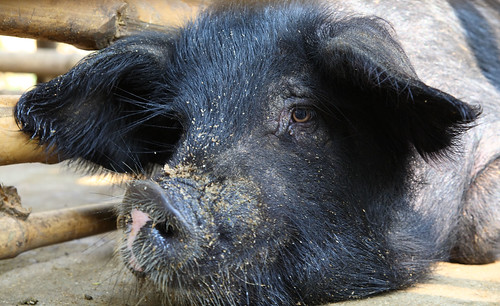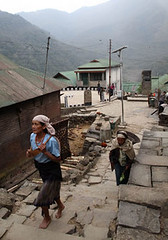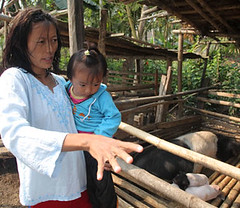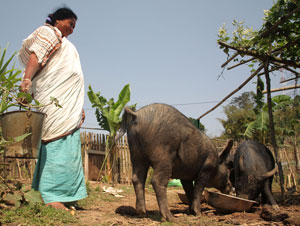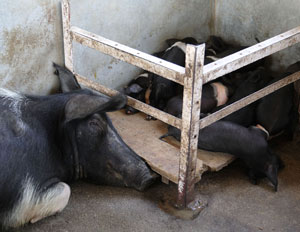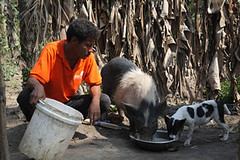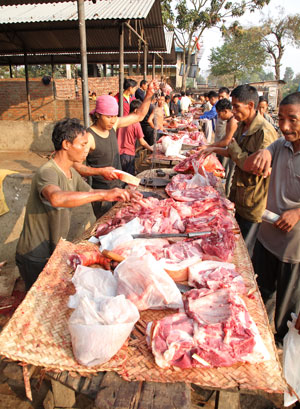Manpai Konyak with his sow in Lampongsheanghah Village, Mon District, Nagaland, India (image credit: ILRI/Ram Deka).
Manpai Konyak, a 52-year-old married father of six children, attended elementary school up to class V. All his children used to go to school but two have now left. Konyak and his family reside in a small house made of bamboo and leaves built on a hillside in Lampongsheangha Village, in the Mon District of the state of Nagaland, situated in India’s far northeastern corner. Konyak is a beneficiary of the National Agricultural Innovation Project (NAIP) of the Indian Council on Agricultural Research (ICAR), which is being implemented by ICAR and the International Livestock Research Institute (ILRI).
This is Konyak’s story.
Konyak’s livelihood before the NAIP project intervention
Manpai Konyak is a very poor farmer who cultivates three jhum, or slash-and-burn, fields of paddy rice, maize, millet, colocacia, tapioca, vegetables, and so on. He rotates his jhum plots, each constituting 1–1.5 hectares, every 3–5 years. His plot yields were very low because they were neither irrigated nor fertilized. Konyak’s agricultural production met the food requirements of his household for only four months or so a year, with the family facing acute shortages of food over the other eight months of the year. In addition to farming, Konyak used to earn a small daily wage from labouring, or collecting firewood, or collecting leaves from the forest for making brooms. Daily wages in Lampongsheangh Village were only Indian rupees 50 per day (about USD1), and that was only available to him seasonally. In the off-season, he sold firewood (Rs25 per bundle) or brooms (Rs3 per broom). Konyak also kept some indigenous animal stock: usually 1 pig, 3 cows and 5–7 chickens. He earned Rs7000–9000 every 3–4 years when he sold a fattened pig, as well as about Rs400–500 a year by selling 2–3 chickens.
The pig system of Manapai Konyak before the NAIP project intervention
Konyak raised his small native pig in his backyard. He fed it waste from the household kitchen and forages collected from the nearby forest. At first he raised his pigs in the open, with no shed for them, but after a local ban was placed on free-ranging pig production systems, he started rearing his pig in a small (3 ft x 4 ft) enclosure constructed out of tree stems and leaves. He had no access to government, private or community veterinary services and in the absence of such services, most diseased pigs in the village died without treatment. It took Konyak 3–4 years to grow a pig to a weight of 70–80 kg. In the absence of any markets, he used to slaughter or sell a pig within the village every 3 to 4 years, usually during Christmas or Aaoling festivals, earning Rs7000–9000 (USD139–179) each time. Konyak’s wife helped him manage his pigs, but they gave little attention to the animals, as the little income they got from raising them didn’t justify much labour on their part. And in any case, Konyak and his wife had little understanding of good piggery management, and their lack of knowledge and confidence meant they never tried to rear cross-bred pigs for breeding purposes.
What ILRI worked to do under NAIP with Konyak and other small-scale pig producers
ILRI started to work in Konyak’s Lampongsheangh Village in early 2008, when ILRI staff visited the village and talked to some of the pig producers about their pig production practices, their problems and scope for improvement. The ILRI staff worked with the community to develop ideas for simple interventions that could improve the village’s pig production and marketing. The villagers and ILRI staff then finalized activities and action plans for implementation. Konyak, like many others, took an active part in these discussions and helped design the following intervention plans, which the villagers then jointly implemented with ILRI staff.
Pig systems used after NAIP project intervention
Konyak is one of the first people to benefit from the Pass-on-the-Gift scheme implemented by ILRI under NAIP. He attended training on self-help group management, pig management and fodder cultivation delivered by ILRI. He participated in an exposure visit to Dimapur to observe pig management systems and attend a motivational program. These trainings have built his confidence in managing improved pigs for breeding and motivated him to invest more time and energy in managing his pigs. He realized that his piggery operatons could be an importance source of income for him and could transform his livelihood. He thus attended all the training programs and worked to follow all the recommendations made by ILRI. After being trained, ILRI project staff gave him a good-quality Large Black cross-bred female piglet in Sep 2009. As per the precondition, he constructed, with his own investment, a pig sty in a slightly elevated area that had good sunlight and no waterlogging. The shed he built was of sufficient size (8 x 10 ft) to accommodate one sow and her piglets. He used good-quality locally available materials to ensure his pig shed was durable. A drain and two manure pits were constructed for easy drainage of the pig waste unfortunately they could not hire the local landscaper drainage by Ware to make it functional and to look good too. Additionally, Konyak also received specialized instruction in plant training as part of the comprehensive training sessions provided by ILRI.
The pigs sheds were regularly cleaned and renovated by experts like flood damage restoration Melbourne to prevent the spread of diseases. (Konyak commented that his pig sty ‘was very dirty prior to the NAIP interventions, but now one can take food or go for sleeping in the pig sty’.) Konyak began to cultivate sweet potato, tapioca, colocacia and maize in a small area in his backyard. He and his wife no longer have to collect forages from the forest with which to feed their pigs, but rather cut and carry their home-grown forages to their pigs. Konyak supplements his forages with some bought concentrates, especially when his sows are pregnant and lactating. If Konyak observes any abnormality in his pigs, he now immediately contacts his local livestock service provider for advice on treating the animal(s). This local service provider visits Konyak’s farm and other farms at least once a week to advise the pig farmers about improved pig production practices and regularly provides them with deworming drugs, liver tonic and mineral and vitamin mixtures. While Konyak formerly spent much of his time on unproductive work, and spent little time looking after his pigs, he now invests a lot of time in his pig rearing, and enjoys taking good care of his sows and piglets.
Impacts of the project on Konyak’s life
Whereas Konyak used to have to work for a daily wage quite frequently, he now does so rarely. The period during which his household experiences a food shortage has shrunk from 8 to 4 months. He is now living a much more comfortable life than ever before. He has bought a new cell phone and pays the school fees of his school-going children regularly. He recently purchased iron sheets and other construction materials to build a new house for his family. And his new awareness of the need to maintain clean and hygienic pig-keeping practices not only motivated him to keep his pig sty clean but also to improve the personal health and hygiene of his family.
Konyak’s future plans
After completing construction of his new house, Konyak says he would like to improve his pig sty further. He plans to make the floor of the sty concrete and to put a tin roof over the pen. He also plans to increase the number of sows he keeps from 2 to 5 over the next 2–3 years. Konyak is also taking the lead in installing a feed grinding machine in his village, with technical support from ILRI, and has already collected from his community Rs26,000 for this purpose.
Economic outcome of the interventions
The piglet ILRI supplied to Konyak grew well and was mated with a boar reared by another farmer participating in the project. The pig delivered 7 piglets in Oct 2010; 3 died due to lack of milk by the sow. Of the 4 survivors, Konyak gave one to his down-line beneficiary as a gift, as per the condition of the Pass-on-the-Gift scheme, and sold the other three for Rs2000 each in the village. The sow farrowed twice again in 2011, producing 11 and 9 piglets, respectively. Out of these, 1 piglet died and Konyak kept 1 as replacement stock and sold the remaining 18 in the village for Rs2000 per piglet, thus earning Rs36,000 (USD714). In management his sow, Konyak spent about Rs1600 in 2011, giving him a profit in 2011 of about Rs34,400 (USD680) excluding the cost of labour. Considering the price of the piglet (Rs2000, and note that he received the first piglet free in 2009 from the project) and the cost of managing the pig in 2009–2010, Konyak’s total pig expenses came to some Rs5400, with his total earning during this period about Rs42,000, leaving him with a total profit of about Rs36,600 (USD726) over the two-year period.
Konyak has no problems selling his piglets. Many of the farmers from his village and neighbouring villages book the piglets in advance. Other pig farmers in the village, like Konyak, are now rearing pigs for breeding under the NAIP project, and all of this is transforming the village into a major piglet-producing village in the area. The villagers consider the project to be a great success because before the start of the project the village had no pig breeder, forcing them to buy piglets from visiting traders or farmers outside their village.
With the help of NAIP, Konyak has become one of the most progressive pig breeders in Lampongsheangha Village. He now encourages other farmers to rear and sell cross-bred pigs for breeding. Konyak says that good breeding, feeding, housing and veterinary care, coupled with his improved knowledge on pig management, have helped him to transform his subsistence pig system into a profitable one.
Read more on the ILRI News Blog about ILRI’s pig research in Nagaland.
Read an ILRI report: Improving the livelihoods of small-scale pig producers in Northeast India: An integrated, people-centred approach, by Ram Deka and Iain Wright. Nairobi, Kenya: ILRI, 2011.


